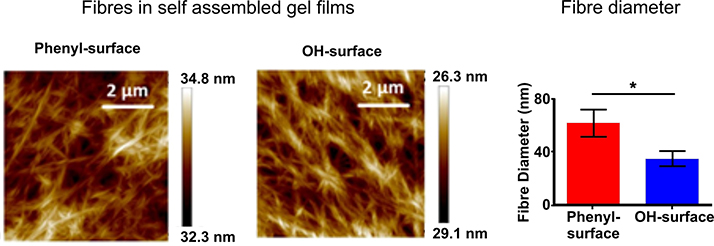Self-assembly at interfaces
Self-assembled structures are common in biology as boundaries (lipid bilayers) and as components for larger, functional and versatile constructs (e.g. the cytoskeleton and focal adhesions). A variety of materials have been designed to prepare functional supramolecular materials in bulk. Controlling self-assembly processes other than self-assembled monolayers (SAMs) from a surface is rapidly gaining interest to create new types of interfacial structures.
We are interested in studying the effect of surfaces on self-assembly processes and use surfaces as templates for the formation of self-assembled structures.
Surface directed self-assembly

AFM images of self-assembled fibres formed by C8-deoxy-cytidine on two chemically different surfaces. The average diameter of the resulting fibres is smaller on the more hydrophilic surface, demonstrating that self-assembly is affected by interfacial interactions between the molecules and the material surface.
Ongoing Projects:
- Investigate the mechanism of surface directed self-assembly.
- Apply surface directed self-assembly to control the properties of supramolecular materials.
References
- Angelerou, M. G. F.; Sabri, A.; Creasey, R.; Angelerou, P.; Marlow, M.; Zelzer, M., Surface-directed modulation of supramolecular gel properties. Chem. Commun. 2016, 52 (23), 4298-4300.